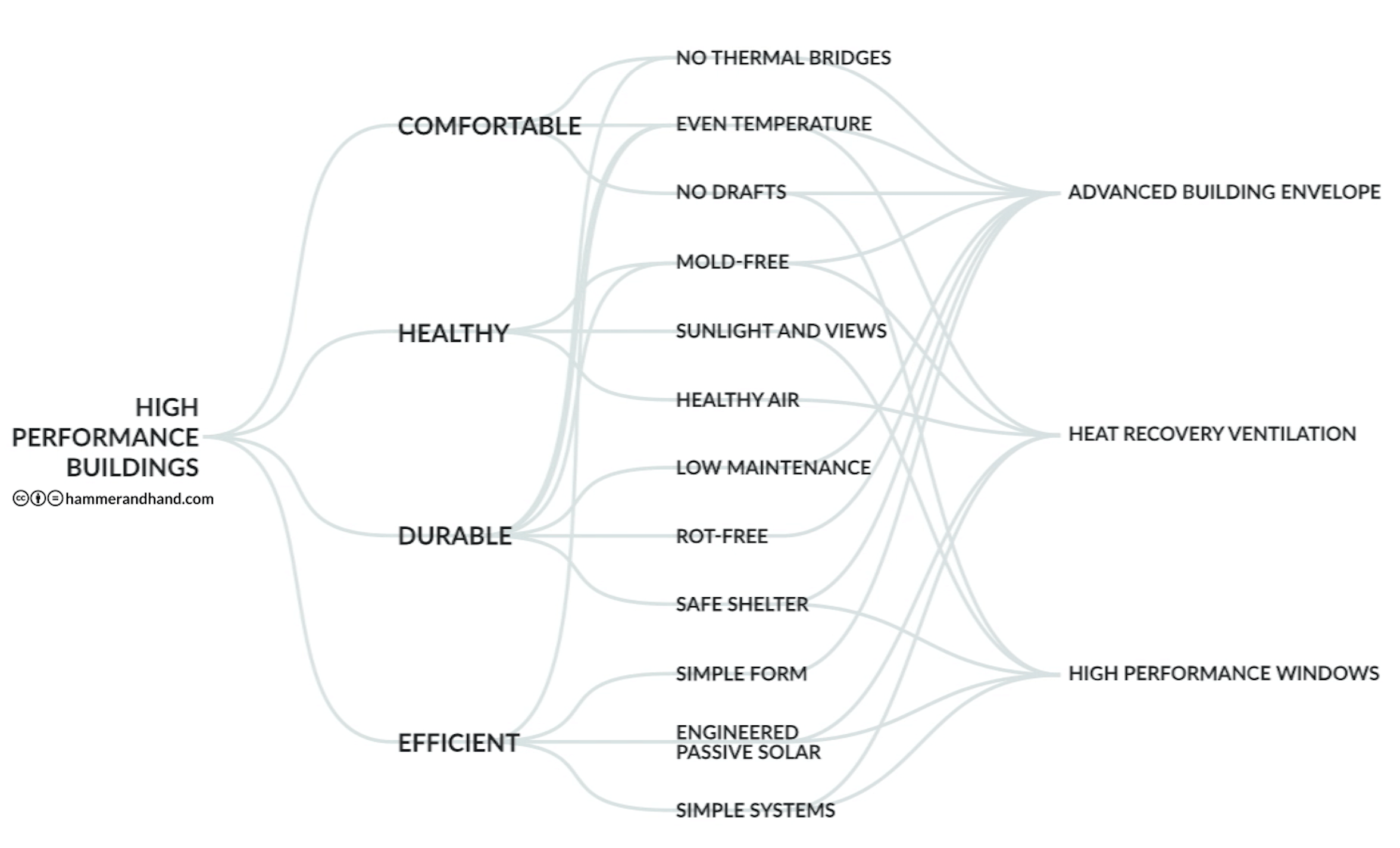The Importance of Planning for High Performance
Residential homes consumed about 15% of the total energy used in the United States in 2023. This equals roughly 11.3 quadrillion Btu (US Energy Information Administration). The majority of this energy use is due to homes not being properly air-sealed or insulated because they were not designed or built to operate at today’s standard of efficiency, driven by energy codes. If houses are designed specifically to operate at high performance we can drastically reduce the energy consumption within the residential sector.
Understanding High Performance
High performance in home design is defined by several key factors: energy efficiency, comfort, health, and durability.
1. Energy efficiency is referencing appliances, lights, and mechanical systems operating at their highest potential while using the least amount of energy required; typically a technological consideration.
2. Comfort and health implies that the indoor air temperature, humidity, and air quality consistently meet occupant needs through the entire home.
3. Durability refers to how well a building withstands weather events and remains structurally sound over a long period, ideally lasting a lifetime or more.
Elements within a house design that make it high performance include proper insulation values that meet or exceed code, high performance HVAC systems that are installed optimally, and sized appropriately for the building. Comfort and health is acheived by well designed mechanical equipment including robust balanced ventilation and the utilization of materials with low toxicity levels.
The Benefits of Planning Ahead
When a house is designed with a goal of high performance at the start of the design phase there are many benefits for the homeowner down the line.
Energy Savings: Homes designed for efficiency consume less energy, lowering utility bills and reducing environmental impact.
Comfort: Consistent temperature regulation and improved air quality enhance the living conditions within the home.
Durability: High-performance homes use materials and systems that last longer, reducing the need for repairs and replacements.
Resale Value: Efficient homes are more attractive to buyers, increasing their marketability and value.
Low Embodied Carbon: Using sustainable materials and efficient systems reduces the carbon footprint of the home.
Figure 1 - Breakdown of high performance building benefits.
What Actions Involve Planning for High Performance?
Several key actions are involved in planning for a high-performance home:
Site Selection: Choosing the right site involves considering orientation for solar gain, natural shading, and wind protection.
Building Envelope: Ensuring high-quality insulation, windows, and air sealing are crucial for maintaining efficiency.
Systems Integration: Efficient HVAC, plumbing, and electrical systems are essential for high performance.
Sustainable Materials: Selecting environmentally friendly and durable materials contributes to the overall efficiency and sustainability of the home.
How Does This Affect HERS Ratings?
If a house is designed for high performance it is very likely going to receive a well passing projected HERS score. When a house has a low/passing projected HERS score it leaves breathing room for the builders and homeowner to allow for change orders and freedom to choose appliances. This creates a less stressful and smoother building process for all parties involved (builders, installers, homeowners, HERS raters, and other inspectors). When the time comes for a final HERS rating after the blower door and duct testing, there will be minimal question on whether the building will pass code requirements or not. Essentially, a high performance home does not only benefit the owner/occupant in livability and reduced energy costs, but reduces risk in code compliance testing and HERS modeling.
On the other hand, when a house is not specifically designed for high performance, there is a running risk that the projected HERS score will not meet code forcing the builder and homeowner to walk a tighter rope through the building process adding to the stresses of construction, and leaving too much up to the builder to execute. A good design, means there is less mystery of how success will be achieved. For instance , some builders have incorporated best practices, such as excellent airbarrier installation. However, others have not- and by not designing - literally drawing- the airbarrier, you risking failure and excessive energy waste.
Figure 3 - Example of a low and passing projected HERS score. This is what builders/homeowners receive before final inspections take place.
Impact of High Performance Homes
High-performance homes offer numerous benefits, including lower utility bills, enhanced comfort, greater durability, increased resale value, and smaller carbon footprints. By focusing on energy efficiency, proper insulation, and sustainable materials during the design stages, homeowners and builders can create homes that meet and exceed current energy codes. This proactive approach not only ensures a smoother building process but also contributes to a more sustainable and comfortable living environment for the long term, all while reducing energy consumption and bringing society closer to its climate goals.



